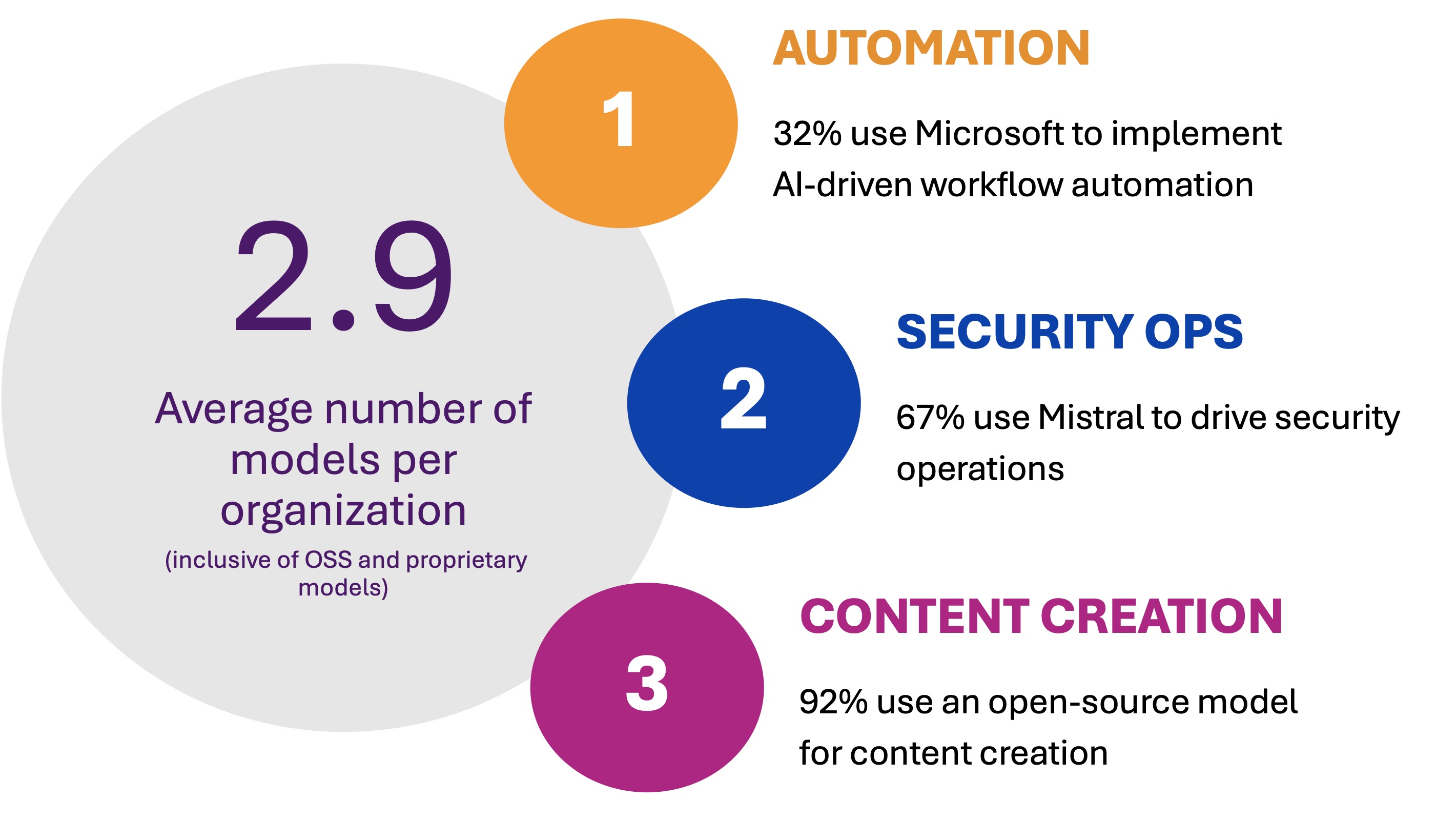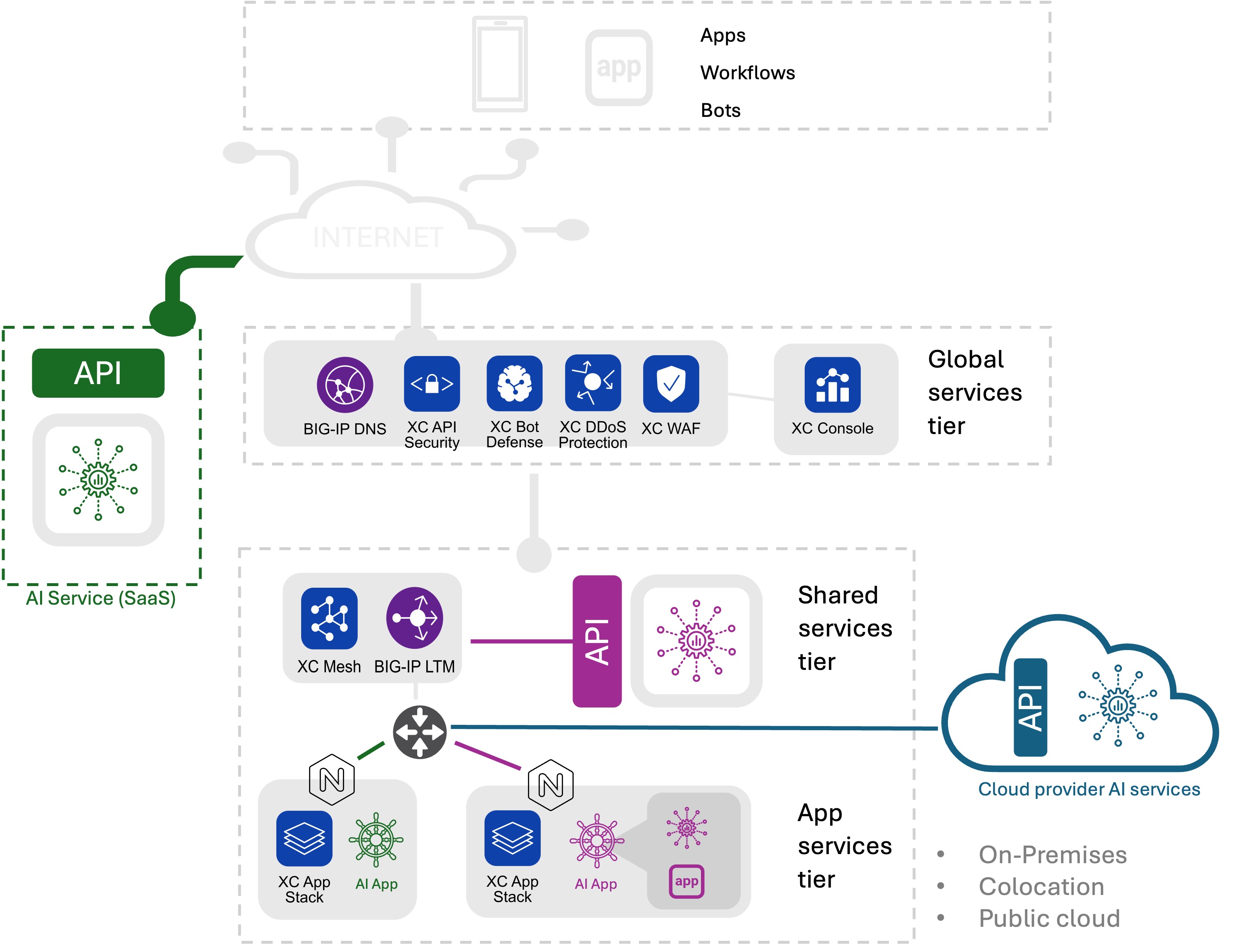생성 AI에서는 "모든 것을 지배할 수 있는 하나의 모델"이 없습니다.
헤드라인을 기준으로 보면, OpenAI는 현재 유일한 생성 AI 게임입니다. 이 대화에서도 AI에 대한 대화에서 항상 언급됩니다. 하지만 이것이 유일한 서비스는 아니며, 이용 가능한 유일한 모델도 아닙니다.
사실, 기업에서 생성적 AI를 도입하는 방식은 기사에서 생각하는 것만큼 동질적이지 않습니다.
우리의 최근 조사에 따르면, 기업들은 평균적으로 거의 세 가지 다른 모델을 운영하고 있는 것으로 나타났습니다. 그러한 선택의 이유는 사용 사례에서 비롯된 것으로 보입니다.

예를 들어, 보안 운영의 사용 사례가 오픈소스 모델로 옮겨가는 것은 놀라운 일이 아닙니다. 오픈소스 모델은 프로세스와 중요한 기업 데이터를 노출할까봐 두려워하지 않고도 비공개로 훈련을 받을 수 있습니다. 이는 콘텐츠 생성에도 해당하는데, 콘텐츠 생성을 위해서는 종종 민감한 데이터를 모델과 공유해야 합니다. 온프레미스와 Azure 모두에서 Microsoft 솔루션과 긴밀하게 결합된 많은 조직이 있기 때문에 워크플로 자동화 사용 사례가 Microsoft의 호스팅 서비스를 찾는 것도 놀라운 일이 아닙니다.
단일 모델로는 기업 사용 사례를 위한 생성적 AI 의 증가하는 목록에 대한 모든 기술적, 비즈니스적 요구 사항을 충족할 수 없습니다.
이는 앱 제공, 보안 및 일반 운영 측면에서 일부 과제를 야기합니다. 다양한 모델 선택은 서로 다른 배포 패턴을 의미하기 때문입니다.
새로운 AI 배포 패턴

- SaaS 관리형 . SaaS 관리형 배포 패턴에서 AI 애플리케이션은 API를 사용하여 AI 관리 서비스에 액세스합니다. 이는 OpenAI ChatGPT와 유사합니다. 규모에 대한 운영적 책임은 공급자에게 있습니다.
- 클라우드 관리 . 클라우드에서 관리되는 배포 패턴은 클라우드 공급자가 호스팅하는 AI 서비스를 활용합니다. 이러한 서비스는 여전히 API를 통해 접근하지만 기업에서만 사용할 수 있거나 공유될 수 있습니다. AI 앱 자체도 퍼블릭 클라우드 나 온프레미스에 있을 수 있습니다. 서비스가 비공개인 경우 기업이 추론 서비스의 확장에 대한 책임을 맡게 되는데, 대부분의 조직은 대규모 언어 모델을 확장한 경험이 거의 없기 때문에 이는 어려울 수 있습니다. 서비스를 공유하는 경우 조직은 클라우드 제공자에게 책임을 전가하지만 운영의 일환으로 할당량 및 토큰 기반 비용과 같은 요소를 고려해야 합니다.
- 자체 관리 . 오픈소스 모델은 퍼블릭 클라우드와 온프레미스 모두에서 자체 관리형 패턴으로 배포될 가능성이 가장 높습니다. 모델은 API를 통해 접근하거나 애플리케이션을 통해 직접 접근할 수 있습니다. 이 패턴에서 조직은 추론 서비스의 확장, 보안 및 모니터링에 대한 전적인 책임을 맡습니다.
(이러한 패턴에 대해 더 자세히 알아보려면 Chris Hain의 이 블로그를 확인하세요)
SaaS 관리 패턴을 지원하는 오픈소스 모델을 호스팅하는 수많은 공급업체가 있으며, 오픈소스를 서비스로 제공하는 클라우드 공급업체도 많습니다.
OpenAI 모델은 OpenAI를 통한 SaaS 관리 패턴으로만 제공되는 것이 아니라, Microsoft를 통한 클라우드 관리 패턴으로도 제공됩니다. 인기 있는 오픈소스 모델인 미스트랄은 세 가지 패턴 모두에 배포될 수 있습니다. 기업이 모델과 배포 패턴을 혼합하고 일치시킬 수 있기 때문에, 우리는 사용 사례를 모델 선택의 주요 동인으로 봅니다.
기업들은 이미 모델을 훈련하는 데 필요한 기술뿐만 아니라 모델을 운영하고 보안을 강화하는 데 필요한 기술과 관련하여 압박을 느끼고 있습니다. 따라서 운영 전문 지식이 부족한 많은 조직에서는 사용 사례에 따라 모델을 일치시키는 것이 가장 합리적입니다. 보안이나 개인정보 보호 이유로 공유 패턴으로 배포할 수 없는 사용 사례에 리소스를 집중하면 궁극적으로 가장 좋은 결과를 얻을 수 있습니다.
운영 근시에 주의하세요
하지만 조직 내부에 고립이 생길 수 있는 운영상의 근시안적 시각의 위험에 주의하세요. 우리는 클라우드 컴퓨팅에서 이런 일이 일어나는 것을 보았고, 의심할 여지 없이 기업을 위한 생성 AI에서도 다시 이런 일이 일어날 것입니다. 하지만 모델별로 운영과 보안을 분리하는 데에는 위험이 있다는 점을 알고 있다면 조직에서는 이로 인해 발생하는 복잡성과 위험을 피하고 운영 리소스, 역량, 예산을 최대한 활용하는 모델과 배포 패턴을 전략적으로 선택할 수 있기를 바랍니다.
아직 초기 단계이므로, 이 글을 읽으실 때쯤이면 새로운 기능을 갖춘 새로운 공급업체와 새로운 모델이 등장할 것이 틀림없습니다. 하지만 배포 패턴은 대체로 동일하게 유지되므로 예산부터 인력, 보안 및 확장에 필요한 앱 서비스에 이르기까지 운영과 관련하여 보다 전략적인 계획이 가능합니다. 어떤 모델을 선택하든 상관없습니다.
